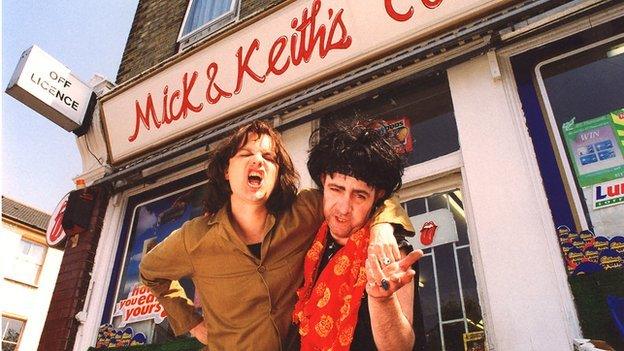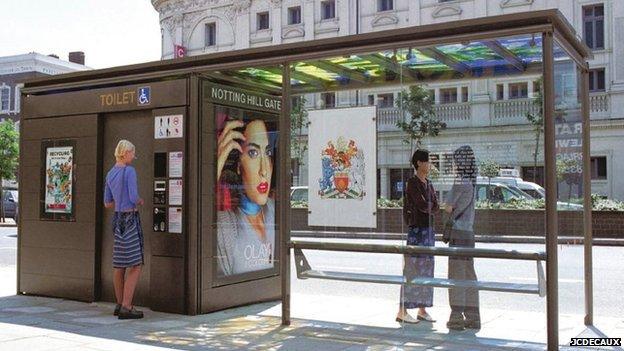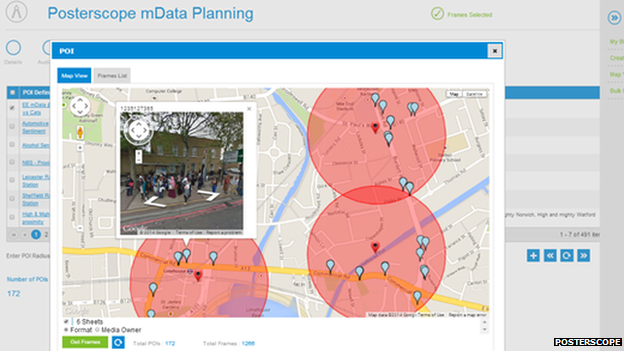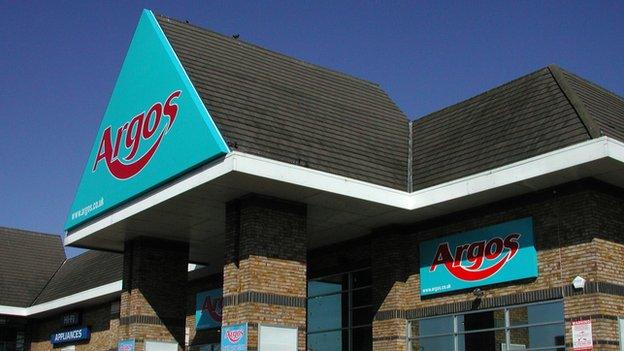Location tech and mobile map out way to better business
- Published

Surbiton: Home of BBC TV's Stella Street, The Good Life... and online fashionistas?
Surbiton would not normally be thought of as a centre of fashion.
But it is, according to location data analysts at least.
This south west London suburb, home to BBC TV's fictional Stella Street celebrities, is where young people are more likely to check out fashion sites and apps on their smartphones than almost anywhere else in the UK.
The surprising insight comes from mobile phone network EE, which has collated terabytes of anonymised and aggregated data on more than 20 million UK customers - data that is proving increasingly valuable to retailers and advertisers.
The internet has been a godsend for marketers - enabling them to track our online behaviour to the nth degree.
Now location data from mobiles and other sources has added a whole new layer of detail to the picture - a step-change analogous to the move from videotape to DVD.
"Location analytics are becoming integral to every business strategy," says David Brussin, chief executive of Monetate, a digital marketing company.
Poster boys and girls
US marketing pioneer John Wanamaker once famously said: "Half the money I spend on advertising is wasted; the trouble is, I don't know which half."

Companies now know which individual bus stop is better than another for a particular type of ad
Location analytics is helping to solve that conundrum.
Out-of-home (OOH) advertisers and agencies - those responsible for ads on billboards, bus stops and other physical locations - now know what type of person is passing a specific location at any one time, and what they are doing online.
They can then target their ads accordingly.
"Thanks to location data we now understand the relevance and value of a particular advertising position compared with another," says James Davies, chief strategy officer at OOH agency Posterscope.
"For instance, commuters at one station may tend to look at financial apps on their phones, whereas people travelling from another station may prefer fashion apps," he says.
"Knowing this helps advertisers ensure their ads are relevant, which saves money and improves effectiveness."

By combining mobile phone location data and online behaviour analysis, firms can pinpoint the best places for their ads
With brands spending nearly £1bn a year on outdoor advertising in the UK, relevance is key to getting more bang for your marketing buck.
Posterscope says its partnership with EE has seen advertising effectiveness triple for some of its clients, who include Lenovo, Nationwide and British Gas.
"We now know which bus stop is better than another on the same street," says Mr Davies.
Music for you
The mobile phone is not only an excellent tool for locating consumers, it is also an increasingly effective way for brands to interact with them.

Joyce DiDonato performs at the Last Night of the Proms at the Royal Albert Hall in 2013
When people move into a particular zone - crossing a geo-fence as the jargon has it - marketers can send highly targeted offers to their phones - ads relevant to their age, interests and purchasing histories.
For example, during last year's Proms music festival, which centred around South Kensington's Royal Albert Hall, Decca Records sent text messages to classical music lovers in the locality offering them free track downloads of artists featured in that night's programme.
At first, the campaign looked liked proving a damp squib - the geo-fenced area was too narrowly focused around the venue.
.jpg)
Location marketing in action: Decca Records offered free classical music tracks to visitors to Proms 2013
But as soon as this was widened to include nearby tube stations, the response rate improved dramatically, the company says.
The campaign illustrated how location analytics could help reach an older demographic that is normally hard to engage, argues Sean O'Connell, director of product and technology at Weve, a joint venture between mobile phone networks Telefonica, Vodafone and EE.
Weve provided Decca's location-based customer data and helps many other businesses with their marketing campaigns. About 60% of its campaigns in 2013 "included a location element", says Mr O'Connell.
"The Decca campaign shows how specific and bespoke your marketing can be. And you get much more engagement with this type of marketing - click metrics improve three or four times," he says.
Personalised offers
"Location and context aware offers are going to change the world," says John Bates, chief marketing strategy officer of big data specialist Software AG.
"Say you're walking past a designer shoe store, you could receive a mobile ad offering a 30% discount off Jimmy Choos if you come in within the next 30 minutes and use a particular credit card.
"This is how the High Street can fight back against Amazon," he adds. "The real world is fighting back against the virtual world - it's personalisation on a massive scale."
Monetate's David Brussin agrees, saying: "A retailer can offer customers a promotion online, via email or on mobile, which changes dynamically based on their location, highlighting the shop physically closest to them and directing them to visit, and ultimately buy."
But this kind of highly personalised marketing will only work if consumers are happy to trade some privacy in return for the benefits, Mr O'Connell believes.
"All such services are opt-in," he says. "Customers give their permission to be indentified. With location technologies, being able to say no is of paramount importance."
Smart maps
Location data can also help businesses map out ways to improve - literally.
For example, Esri, a specialist in location data mapping, mashes together all sorts of data - censuses, social media streams, weather, land surveys - then adds in location data gleaned from wi-fi, phone masts, GPS, and card transactions.
"Static data is being enhanced by real-time data, and this is making maps dynamic," says Sharon Grufferty, head of software-as-a-service product management for Esri UK.
"Companies can locate hotspots of Twitter sentiment on a map, for example, and pinpoint where a problem exists, enabling them to tackle it quickly," she adds.

Argos used location analytics to select the best sites for its "click-and-collect" stores
Such analysis is helping insurers assess household risk far more accurately, energy companies pick the ideal place for a wind farm, and retailers plan their stores, says Ms Grufferty.
For example, retailer Argos, part of Home Retail Group, used Esri's location mapping expertise to help it decide the best locations for its "click-and-collect" centres, based on in-depth analysis of online and in-store customer behaviour and geo-demographics.
The underperforming, badly located stores were jettisoned, while new and existing stores were stocked more efficiently to suit the local clientele.
"Home Retail Group have been long-term users of mapping software and insight," says Andrew Stringer, the company's customer and market insight controller.
"It helps to identify more areas where we can offer great convenience to our customers."
These days, the old adage "location, location, location" seems to apply as much to business as it does to property investment.